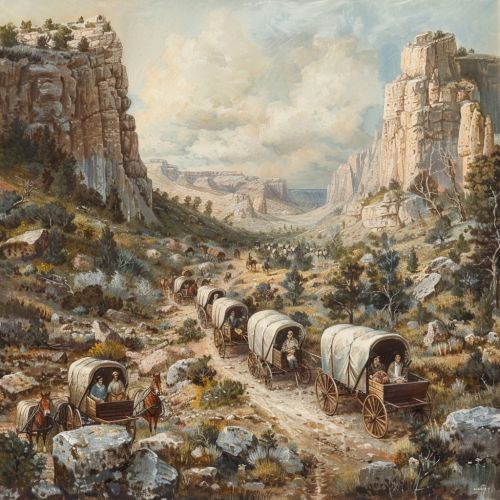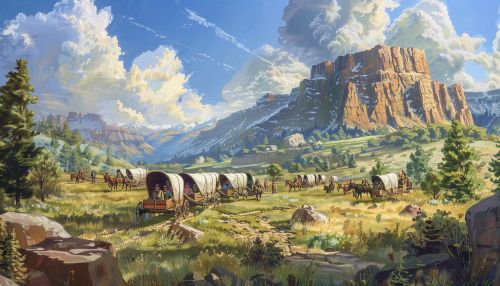Mormon settlers
Introduction
The term "Mormon settlers" refers to the members of The Church of Jesus Christ of Latter-day Saints (LDS Church) who migrated to the western United States during the 19th century. This migration, often referred to as the Mormon Exodus, was driven by a combination of religious persecution, the desire for religious freedom, and the search for a promised land where they could practice their faith without interference. The most significant movement of these settlers occurred between 1846 and 1869, culminating in the establishment of Salt Lake City and other communities in the Utah Territory.
Historical Context
Early Persecution
The early history of the LDS Church was marked by intense persecution. Founded by Joseph Smith in 1830 in upstate New York, the church's rapid growth and unique doctrines led to suspicion and hostility from surrounding communities. This persecution escalated as the church moved from New York to Ohio, Missouri, and Illinois. In Missouri, tensions culminated in the 1838 Mormon War, which resulted in the issuance of the Extermination Order by Governor Lilburn Boggs, effectively making it legal to kill Mormons in the state.
Nauvoo and the Martyrdom of Joseph Smith
In 1839, the Mormons established the city of Nauvoo in Illinois, which quickly grew to rival Chicago in size. However, internal dissent and external pressures continued to plague the community. In 1844, Joseph Smith and his brother Hyrum were murdered by a mob while imprisoned in Carthage, Illinois. This event intensified the already dire situation for the Mormons, leading to increased violence and threats against them.
The Mormon Exodus
Leadership of Brigham Young
Following the death of Joseph Smith, Brigham Young emerged as the leader of the LDS Church. Under his direction, the decision was made to leave the hostile environment of Illinois and seek a new home in the West. Young's leadership was instrumental in organizing and executing the mass migration of thousands of church members.
The Trek West
In 1846, the first groups of Mormon pioneers began their journey westward. They traveled in organized companies, following a route that would later become known as the Mormon Trail. This trail extended from Nauvoo, Illinois, across Iowa, Nebraska, and Wyoming, to the valley of the Great Salt Lake in present-day Utah. The journey was arduous, with settlers facing harsh weather, disease, and scarcity of supplies.


Establishment of Salt Lake City
In July 1847, the first group of Mormon pioneers, led by Brigham Young, arrived in the Salt Lake Valley. Upon seeing the valley, Young declared, "This is the right place," signaling the end of their journey and the beginning of a new chapter in Mormon history. The settlers immediately began constructing homes, irrigation systems, and farms, laying the foundation for what would become Salt Lake City.
Life in the Utah Territory
Community Organization
The Mormon settlers organized their new communities based on religious principles and communal cooperation. The Deseret Alphabet was developed as part of an effort to create a unique cultural identity. Settlements were often planned with a central meetinghouse and surrounding farmland, reflecting the church's emphasis on unity and self-sufficiency.
Economic Development
Agriculture was the primary economic activity for the early settlers, who introduced irrigation techniques to the arid region. This allowed them to cultivate crops such as wheat, corn, and potatoes. Additionally, the Mormons established various industries, including milling, textiles, and mining. The Perpetual Emigrating Fund was created to assist poor converts in migrating to Utah, further boosting the population and economic growth.
Relations with Native Americans
The arrival of Mormon settlers significantly impacted the indigenous peoples of the region, including the Ute, Shoshone, and Paiute tribes. While the Mormons initially sought peaceful relations and engaged in trade with the Native Americans, conflicts inevitably arose over land and resources. The Walker War (1853-1854) and the Black Hawk War (1865-1872) were notable conflicts during this period.
Challenges and Conflicts
The Utah War
Tensions between the Mormon settlers and the United States government culminated in the Utah War (1857-1858). The conflict arose from concerns over theocratic governance and reports of rebellion in the Utah Territory. President James Buchanan sent a military expedition to install a new territorial governor and assert federal authority. Although the conflict did not result in significant bloodshed, it highlighted the deep-seated mistrust between the Mormons and the federal government.
Polygamy and Legal Battles
One of the most contentious issues surrounding the Mormon settlers was the practice of polygamy, which was publicly announced by the church in 1852. This practice led to widespread condemnation and legal challenges. The Edmunds Act (1882) and the Edmunds-Tucker Act (1887) were federal laws aimed at curbing polygamy and disempowering the church. These laws resulted in the imprisonment of many church leaders and the confiscation of church property.
Legacy and Impact
Statehood and Modernization
The Utah Territory continued to grow and develop, eventually achieving statehood in 1896. The church officially discontinued the practice of polygamy in 1890 with the issuance of the Manifesto by church president Wilford Woodruff. This decision paved the way for Utah's admission to the Union and marked a significant shift in the church's relationship with the federal government.
Cultural and Social Contributions
The Mormon settlers made substantial contributions to the cultural and social fabric of the American West. Their emphasis on community, education, and self-reliance left a lasting legacy. Institutions such as Brigham Young University and the University of Utah were established, promoting higher education and research. Additionally, the church's welfare program and humanitarian efforts have had a significant impact both within and outside the Mormon community.
See Also
- Mormon Trail
- Brigham Young
- Nauvoo
- Utah War
- Polygamy in the LDS Church
- Manifesto (LDS Church)
- Perpetual Emigrating Fund
- Deseret Alphabet
